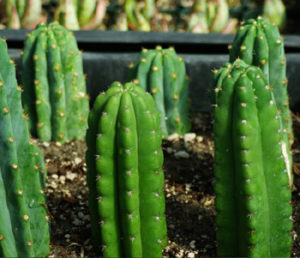
For starters, you can buy cactus mix at the nursery supply store, but most of us make our own. Here’s the common recipe: 50% white pumice, 25% coarse, sharp sand, and 25% organic matter such as coir or compost. Mix thoroughly and inoculate with a handful of cactus mix taken from around growing cacti–this will provide bacterial/fungal substrate that supports the growth of healthy cacti. Use gallon pots or smaller. Fill to 1/2 inch from rim with your cactus mix, then provide a thin (1/4 inch) layer of sifted mix as a seedbed.
To make the sifted mix, run your cactus mix through a 1/8 inch screen. Sprinkle seed on surface and mist or water by setting pot in a bowl of water. Do not dislodge seeds or seedlings by rambunctious watering–its counterproductive. Many growers stretch plastic wrap over the top of the pot to create a mini-greenhouse effect for germination, then remove the plastic once the seedlings are up and going.
Set the pot in the light greenhouse or below full-spectrum grow lights. Optimal temperature is 70 to 90 degrees F. Germination is dependent on temperature, light, moon phase and the species you’re working with, but generally occurs between 1 and 5 weeks after planting. If the seeds do not germinate, allow the pot to completely dry out, then start over. This sometimes jump starts the process.
Once the seedlings appear, keep them propped up with pieces of pumice or gravel. Remove plastic wrap, but keep evenly watered for the first 6 months. After that, during the summer, water every 3 to 5 days, allowing the surface to dry between waterings. Water not at all or very infrequently during the winter. Many growers allow their cacti to grow closely together for the first year or two, then transplant to single pots once they have attained sufficient size to be readily handled. That’s it in a nutshell.